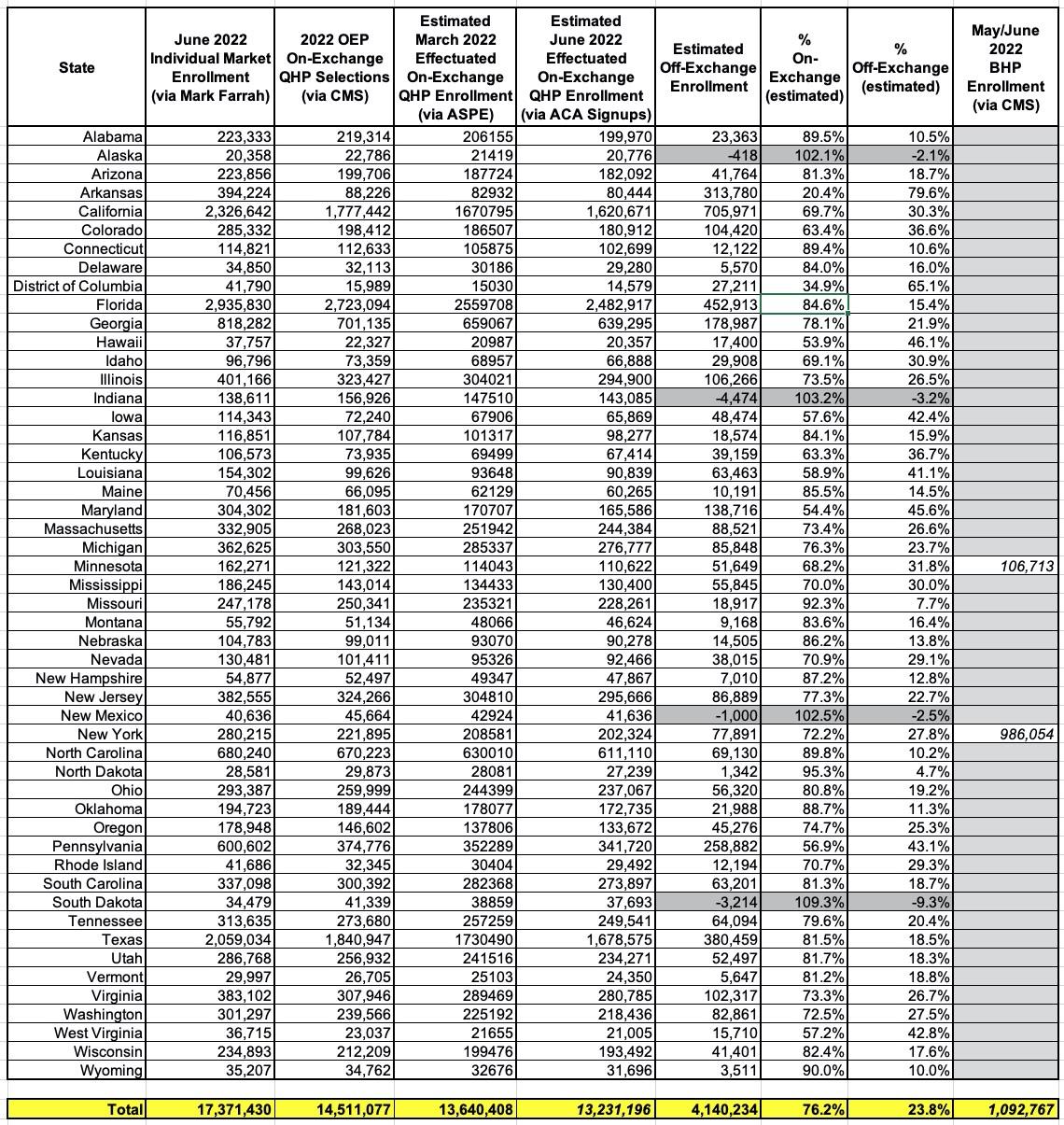Time to check in on the OFF-Exchange ACA Indy Market...

It's been nearly a year since I've checked in on what the off-exchange individual health insurance market looks like. In October 2021, Mark Farrah Associates estimated the total indy market (including both on- and off-exchange enrollees) at around 15.9 million people nationally as of June 2021. Of that, they figured roughly 75.4% of it was on-exchange vs. 24.6% off-exchange.
However, as I noted at the time, there were a couple of important caveats with Mark Farrah's estimates, two of which they mentioned but one of which they didn't:
It is important to note that Mark Farrah Associates (MFA) applied enrollment figures for select carriers not required to report health enrollment on a quarterly basis and made other adjustments based on market analysis. Furthermore, individual enrollment includes short term plan enrollees and may include Medicaid programs, such as CHIP, as some states include subsidized lines in the individual segment. These factors may have resulted in moderate understatement or overstatement of enrollment.
In other words, their estimate of 3.9 million off-exchange enrollees included an unknown number of short-term plan and CHIP enrollees, probably totaling a couple million people.
The other issue which wasn't mentioned by Farrah is that their on-exchange estimate of 12.0 million is based on the number of Qualified Health Plan selections during the 2021 Open Enrollment Period. The problem with this is that 5-10% of those who select QHPs during Open Enrollment don't end up actually being enrolled for even a single month, due to failure to pay their first monthly premium, legal residency verification issues and/or other reasons.
In addition, there's always a slow, gradual net loss of exchange enrollment over the course of the year as people age into Medicare, see income drops which shift them to Medicaid, get a job with medical benefits, move out of state, get married/divorced and so forth. These life changes almost always end up resulting in more people dropping ACA exchange plans month to month than those signing up mid-year, resulting in a net drop in effectuated enrollment.
Case in point: During the 2022 Open Enrollment Period, an all-time recored 14.5 million people selected QHPs as of the end of January...but a few months later, the HHS's Assistant Secretary for Planning & Evaluation (ASPE) issued a report which estimated that the actual number of effectuated exchange enrollees as of March 2022 was around 6% lower across the board, or just 13.64 million nationally.
Well, earlier today Mark Farrah Associates issued their latest individual market enrollment report. Farrah has the total on- plus off-exchange individual market totaling nearly 17.4 million people nationally. However, they used the same methodology as in prior years...including the same on-exchange enrollment error:
Note: Mark Farrah Associates (MFA) applied enrollment figures for select carriers not required to report health enrollment on a quarterly basis and made other adjustments based on market analysis. Furthermore, individual enrollment includes short term plan enrollees and may include Medicaid programs, such as CHIP, as some states include subsidized lines in the individual segment. These factors may have resulted in moderate understatement or overstatement of enrollment.
The table below presents state-by-state breakdowns of the total individual market, separating on and off-exchange membership. For this assessment, MFA applied the assumption that the difference between total individual enrollment reported by carriers and on-exchange, Marketplace enrollment reported in CMS’s Open Enrollment Period (OEP) public use files is a reasonable representation of off-exchange membership. This analysis did not include state-by-state research to provide local market insights about exchange positioning nor did the analysts investigate off-exchange plan options. Nonetheless, the state breakdowns provide a framework for understanding greater market opportunity. These figures indicate 83.5% of individual medical members were enrolled through Marketplace plans and 16.5% were enrolled in off-exchange plans.
Again, I don't have an easy way of estimating the number of short-term plan or CHIP enrollment mixed in with the off-exchange numbers by state, but I can get a pretty good bead on how many on-exchange effectuated enrollees there were in June 2022 by extrapolating from the ASPE's March 2022 estimate. If I knock another 3% off the total from March, that puts each state at roughly 91% of the original QHP selection total from Open Enrollment, like so:
With this adjustment, you end up with just over 13.2 million effectuated on-exchange enrollees as of June 2022, plus another 4.1 million off-exchange enrollees, for a breakout of roughly 76.2% on-exchange vs. 23.8% off-exchange. There's four states where the off-exchange estimate is actually negative, which obviously can't be right, but that was an even bigger issue under Mark Farrah's actual estimate, in which six states showed up with negative off-exchange numbers.
Again, I don't know how many of those 4.14 million off-exchange enrollees are actually signed up for short-term plans or CHIP. A 2020 House Energy & Commerce Committee report estimated over 3 million Americans enrolled in so-called "short-term, limited duration" (STLD) healthcare plans (aka "junk plans" or #ShortAssPlans as I like to call them), but that was before the American Rescue Plan and Inflation Reduction Act dramatically enhanced & expanded ACA financial subsidies to millions more people.
My guess would be that STLD enrollment is probably down considerably since then; combined with the reclassified CHIP enrollees, I'd imagine actual off-exchange enrollment in ACA-compliant individual market plans is probably more like 3 million or so nationally. If so, that would put the total market at roughly 16.2 million, with ~82% on-exchange and ~18% off-exchange. Throw in another ~1.1 million Basic Health Plan enrollees in Minnesota and New York and it's around 17.3 million total.




